Bioluminescence; seems like magic, but actually, it is a chemical reaction. Among all the Bioluminescent animals in deep dark oceans, Bioluminescent Jellyfish are the most popular.
In the ocean, sunlight does not penetrate beyond around 60 meters in depth. Without light, animals can not see things. So, these deep-sea creatures use bioluminescence to see things
By the end of this article, you will learn a lot about Bioluminescence, Bioluminescent Jellyfish, and other Bioluminescent animals you can find both in the ocean and the land.
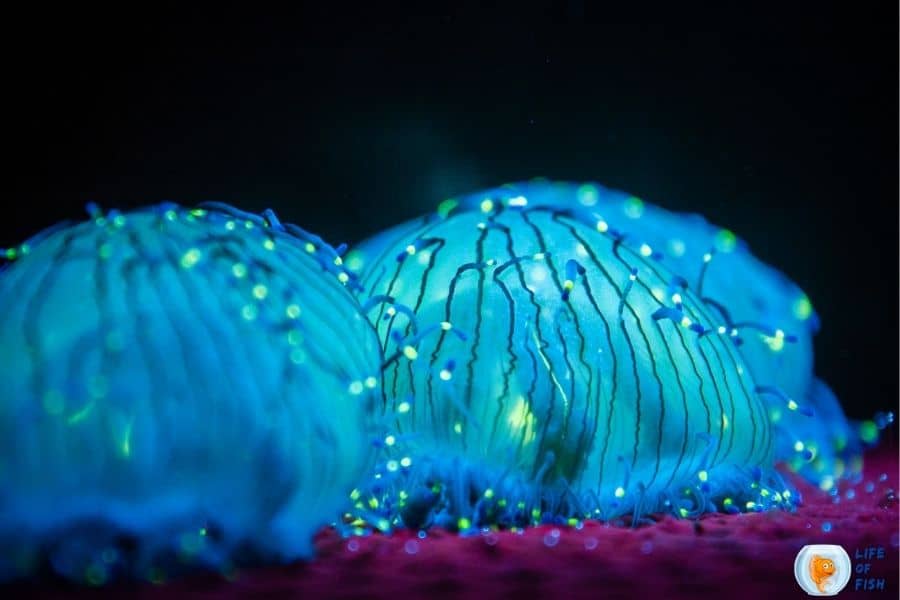
What is bioluminescence?
Jump To
Bioluminescence is a chemical reaction in which animals can produce their own light. It’s one of nature’s most amazing phenomena which scientists are still trying to lose the knots.
However, bioluminescence is relatively rare in the land but very common in the ocean, especially in the pelagic zone (the water column).
Around 80% of marine animals living in the deep waters of about 200 m to 1000 m have bioluminescence, but the most popular bioluminescent aquatic creature is jellyfish.
Bioluminescent jellyfish owe their name to the phenomenon, as they emit a steady stream of blue-green light from a specialized substance called luciferin that reacts with oxygen.
An enzyme called luciferase facilitates this reaction, and it produces light while releasing energy.
This light also knows as cold light. Because it does not produce any heat as other lights.
Sometimes luciferin and luciferase are combined with oxygen to form a single molecule known as a photoprotein.
When an ion, such as calcium, is present, a process occurs that emits light. These photoproteins are found in “photocyte” cells of bioluminescent jellyfish.
An organism must constantly introduce more luciferin into its system to glow consistently. Some animals get it from their diet, while others make their own.
In the case of jellyfish, they mostly produce luciferin in their photocyte cells.
Bioluminescent Jellyfish
There are over 80 different species of bioluminescent jellyfish in oceans around the world.
Scientists believe among all jellyfish about 50% are bioluminescent. They are found in oceans from the surface to great depths.
But, most luminescent jellyfish occur in the deep sea.
In the deep sea, Bioluminescent Jellyfish often live in total darkness, so they come up to the ocean surface at night to feed on plankton and other organisms by creating a disturbance in the water, which attracts their prey close to them.
Then they suck in their food with their tentacles.
Glowing jellyfish use the light from their bodies to attract prey or for defense against predators. The bioluminescence of jellyfish varies from species to species.
Still, certain features are common among all bioluminescent forms: They emit a steady stream of light, and the Bioluminescent light is bluish-green.
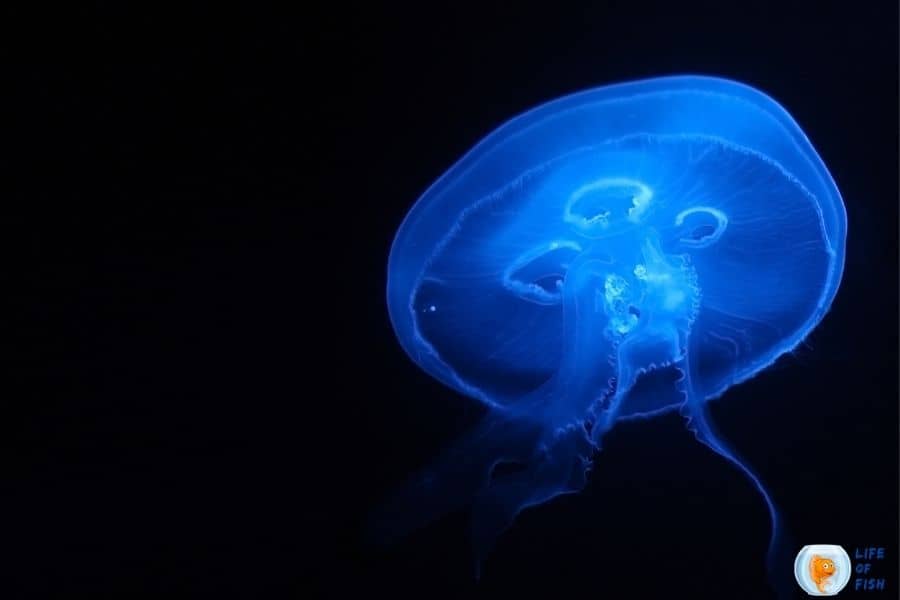
Why do jellyfish glow?
There are many types of jellyfish that exist in the world. Most of them Glow in the dark as most jellyfish live in the deep sea, in the total darkness.
Most jellyfish glow because of the particular chemical reaction in the cells of their tentacles called “Photocytes.”
In most cases, Bioluminescent Jellyfish glow because they need light to help them hunt for food or hide from predators. Here are some examples:
- Prey more easily in the dark water thanks to the bioluminescent jellyfish.
- Bioluminescent Jellyfish use the light from their bodies to attract prey or for defense against predators.
- Bioluminescent jellyfish also uses light to warn others about unpalatable creatures.
Do all jellyfish make light?
Not all jellyfish are bioluminescent, so some of them don’t emit light! But there are many jellyfish that do emit light.
Scientists estimate about 50% of all jellyfish species are bioluminescent.
What jellyfish are bioluminescent?
As we said before, about 50% of all jellyfish species can emit light.
From cnidarians (sea pens, coral, medusae) to ctenophores (comb jellies) and siphonophores that fall under the name “Jellyfish” can produce light.
So, it is hard to tell a jellyfish species that can not emit light. Below is a list of the most common jellyfish types that are bioluminescent.
Moon Jellies (Aurelia aurita)
One of the most common types of jellyfish is popular among aquarists worldwide.
Moon jellyfish are famous for their moon-like body shape and their harmless stings. This is the most popular bioluminescent jellyfish in the world.
Common Nothern Comb Jellies (Bolinopsis infundibulum)
Although comb jelly is not a true jellyfish, these creatures are famous as jellyfish. Bolinopsis infundibulum is a Ctenophore that can produce light.
Another species makes the rainbow effect (lobed comb jelly/ rainbow jellyfish), but that is not bioluminescence.
However, most comb jelly species that live in the deep ocean are bioluminescent.
Crystal jelly (Aequorea victoria)
Crystal jelly is a bioluminescent hydromedusa that lives on the west coast of North America.
This jellyfish is one of the best examples of bioluminescence in jellyfish as it uses two proteins ( aequorin and green fluorescent protein (GFP)) to produce light.
Without bioluminescence, it is nearly impossible to find these creatures as they are entirely transparent and colorless.
Crown jellyfish (order Coronatae)
Crown jellyfish is not a single species, but about 53 recognized jellyfish species that belong to the order Coronatae.
These sea creatures have a crown shape, hence named crown jellyfish. They inhabit deepsea environments and can produce light through bioluminescence.
If someone touch or attack, their bell lights up to startle, mislead, and distract their predators.
Red paper lantern jellyfish (Pandea rubra)
They are hydrozoan species that have a bright red subumbrella. Red paper lantern jellyfish are in the Pacific ocean in extremely deep and cold waters.
Red paper lantern jellyfish also exhibit bioluminescence.
Cosmic jellyfish (Narcomedusae)
Well known for its UFO shape, cosmic jellyfish is a hydrozoan that belongs to the order Narcomedusae. These creatures also inhabit deep waters and can emit light.
Blue Button Jellyfish (Porpita porpita)
Blue button jellyfish is actually a colony of hydroids distributed around the Pacific, Atlantic, and Indian oceans.
You can find them in tropical, sub-tropical, and warmer waters. It looks more like a blue color button, and they also exhibit bioluminescence.
White-spotted jellyfish (Phyllorhiza punctata)
White-spotted jellyfish is a stunning jellyfish that is native to the Western Pacific ocean but widely distributed around the world.
It is a large jellyfish species that can reach up to 20 inches in bell diameter. Also known as floating bells or brown jellyfish, these creatures can also produce light.
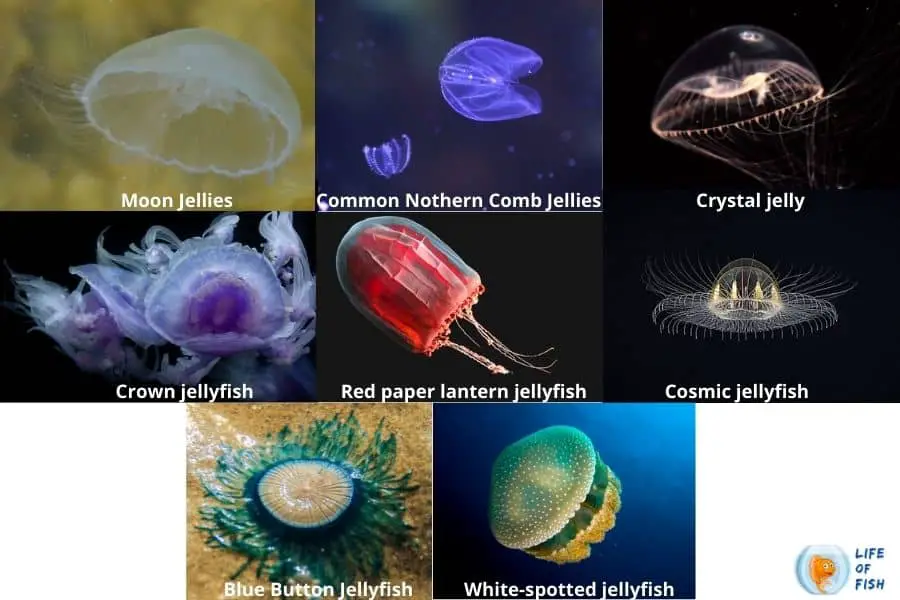
Other bioluminescent marine creatures
Other than Bioluminescent Jellyfish, almost all organisms that emit light are using it to attract prey or self-defense.
Here is some other common example of deep-sea animals that use bioluminescence:
Hawaiian bobtail squid (Euprymna scolopes)
Hawaiian bobtail squid is a small species native to the Central Pacific ocean. It grows about 30mm in length and uses bioluminescence to camouflage by counter-illumination.
Angler fish
The angler fish is a deep-sea fish that uses bioluminescence to attract prey.
Female Angler fish are much larger than males and have large fin extensions on their heads which fold over the body like an umbrella when not in use.
It has a structure called esca at the tip of its dorsal fin, which contains bioluminescent bacteria.
When the angler fish opens its mouth, it spreads the esca out to lure smaller fish close enough to capture.
Firefly Squid ( Watasenia Scintillans)
You can find Firefly squid in Japan, Korea, and China at depths ranging from 200 to 500 meters. They use bioluminescence for communication, camouflage, and attracting food.
Lanternfish
The lanternfish is a large family of more than 200 species found in all oceans worldwide. They’re mostly found at depths of 300 to 1500 meters (980 and 4,920 ft).
Many smaller lanternfish species are bioluminescent, and they mainly use their light for communication, specifically in courtship and shoaling behavior.
They also use their glowing lure to attract prey.
Deep-sea Hatchetfish
The hatchet fish is a type of ray-finned fish and they are similer to a “hatchet.” Because it lives in the depths of the ocean, most of its body has shrunk to conserve its energy.
This type of fish can glow because bioluminescent bacteria live inside the cells of their bodies. Their glowing organs are called “photophores.”
They live in tropical, subtropical, and temperate waters of the Pacific, Atlantic, and Indian oceans.
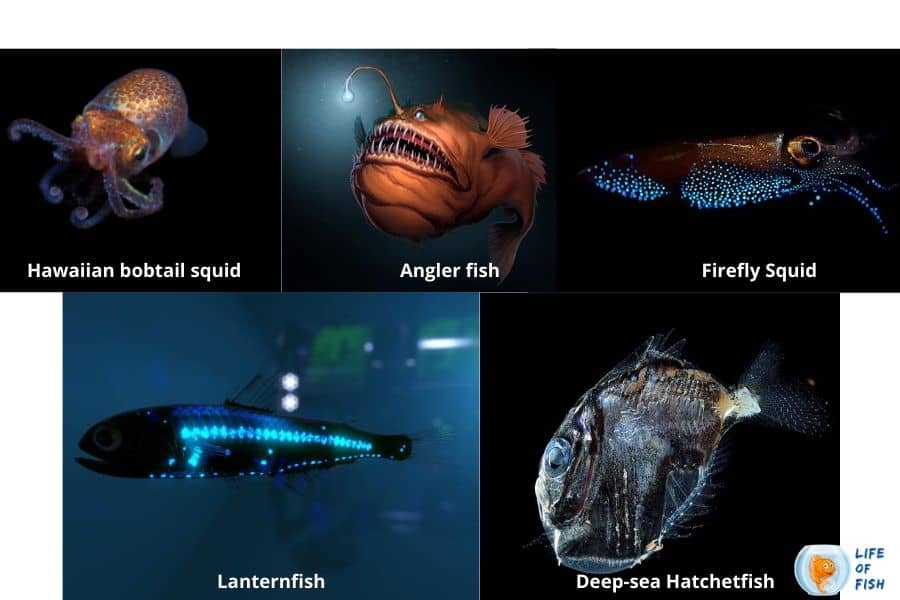
Other Biolminiscent land creatures
Bioluminescence in terrestrial environments is rare. There are only a few numbers of land animals that emit light.
Below is a list of terrestrial animals that are bioluminescent.
Fireflies
Firefly is not a single species but a family of insects in the beetle order Coleoptera.
More than 2000 species of fireflies live around the world, and they emit light to attract mates or prey at midnight.
The color of the luminescent light changes according to the species. They may emit yellow, green, or pale red lights with wavelengths from 510 to 670 nanometers.
You can find fireflies in temperate and tropical climates.
Railroad worms
A railroad worm is a larva or larviform female adult of a Phrixothrix beetle in the Phengodidae family.
It looks like a caterpillar and can emit two different colors of bioluminescence; yellowish-green and red.
Click beetles
also known as spring beetles, snapping beetles, or skipjacks, click beetles are a family of 9300 known species distributed around the world.
Among these species, specific types such as Pyrophorini, Balgus, and Campyloxenus genus can produce light.
Glowworms
glow worms are insect larvae and adult larviform females of beetles. About four families of beetles are bioluminescent; Family Elateridae, Family Lampyridae, Family Phengodidae, and Family Rhagophthalmidae.
The larvae form of these beetles also produces light that can range from green, yellow to orange.
Additionally, the larval stage of Fungus gnats is called “glow worms” found in caves, overhangs, caverns in the rocks, and other sheltered, moist regions. These creatures can also emit light.
Geophilus carpophagus
Geophilus carpophagus is a large centipede species that grows up to 60mm. It has an orange/tan body with a distinctive purplish marble pattern.
According to Wikipedia, the Geophilus carpophagus is a bioluminescent creature that can emit light.
Quantula striata
Quantula striata is also known as Dyakia striata and belongs to the family Dyakiidae. It is a type of land snail that grows up to 5 to 6 cm in length.
It is the only terrestrial gastropod that can exhibit bioluminescence. The adults and juveniles can emit light, but the eggs also produce green light at night.
Annelid
Annelids, commonly known as ringed worms or segmented worms, are a large phylum including more than 22000 species that live in marine, terrestrial and freshwater environments.
According to Wikipedia, annelids are bioluminescent creatures that can produce light at night.
Bioluminescent fungus species
Bioluminescent fungi or bioluminescent mushrooms are often found in tropical and temperate climates around the world.
More than 80 known bioluminescent fungi species are distributed across Asia, Europe, North America, and South Africa. Most of these species are abandoned in the woods.
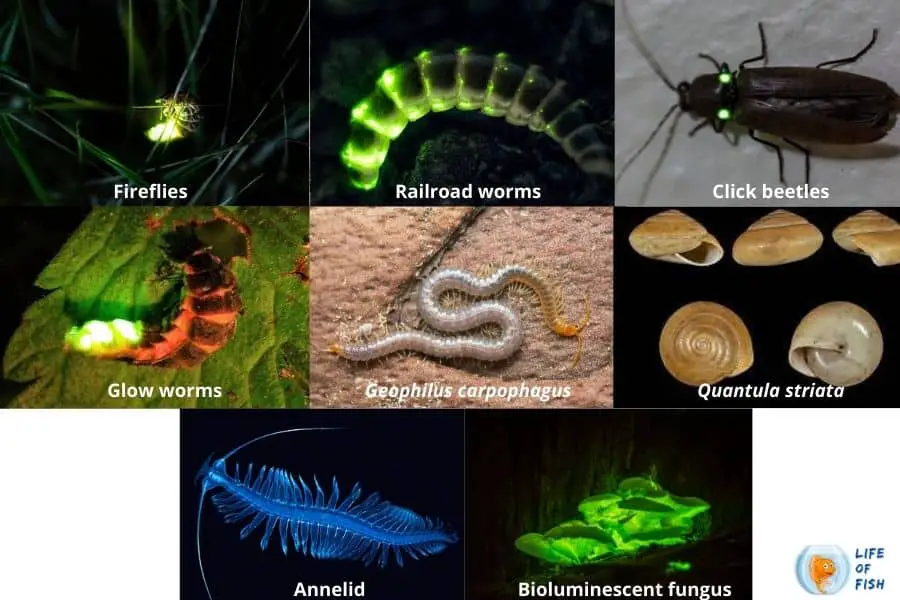
The functions of bioluminescence
Bioluminescence occurs in organisms for several reasons. Many deep-sea creatures have nonfunctional eyes, but bioluminescence provides enough light to see.
It can use as a beacon for potential mates or prey and also use as camouflage. Some of the functions of bioluminescence are,
Attraction
The cirrate octopod “Stauroteuthis syrtensis” has photophores within the animal’s oral reach and uses its bioluminescence to attract its prey.
Click beetle larvae also uses their bioluminescence to attract flying insects on which they feed.
On the other hand, some bioluminescent animals like fireflies use their light to attract mates. In the ocean, ostracods use bioluminescence to attract mates.
Defense
Many animals use their bioluminescence to defense the predators. The functions of defense mechanisms can come from many forms.
- startling prey/predators counter-illumination
- distractive body parts
- smoke screen or misdirection
- sacrificial tag or warning coloration
- burglar alarm
Counter-illumination camouflage
Deep-sea creatures like squids use bioluminescence to camouflage by counter-illumination.
This helps these creatures to save from predators by matching their light with the sea surface above.
Communication
Bacteria, like zooids, use bioluminescence to communicate between colonies.
Mimicry
Some animals, like anglerfish and dragonfish, use their bioluminescence to mimic others. This helps them to attract prey.
Warning
Aposematism is a common function of bioluminescence that warns the creature that it is unpalatable.
Such examples are fireflies, millipedes, jellyfish, scale worms, and brittle stars.
Illumination
Most marine bioluminescent animals emit green to blue light, but some dragonfishes in the genera Aristostomias, Pachystomias, and Malacosteus have red lights that help them to see red-pigmented prey.
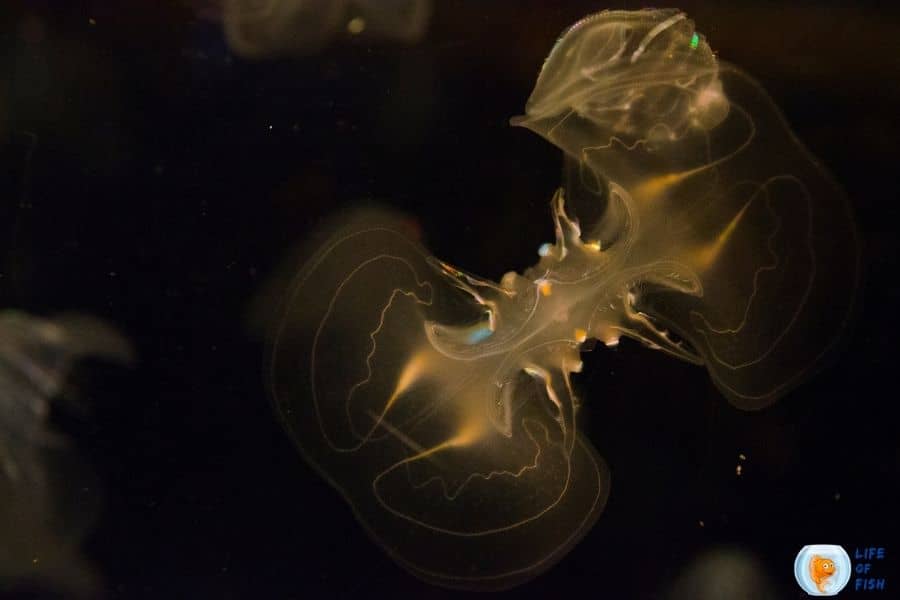
Related question
Where can I find bioluminescent fungi?
Bioluminescent fungi exist, but they don’t produce light on their own.
They provide a substrate for certain species of bioluminescent bacteria, which are believed to use the fungal material as food.
Bioluminescent fungi can be found on decaying plant matter, such as fallen logs.
What colors of bioluminescence are there?
Most bioluminescent creatures emit green and blue lights, and few animals can produce a red glow(e.g., black dragonfish).
Only one known marine creature can produce yellow light(railroad worm).
Most deep-sea creatures can only produce blue and green bioluminescence because the water surface absorbs the red end of the visible light spectrum before it reaches the deeper surfaces.
However, some species in the ocean can emit red and infrared light.
In the land, yellow and green bioluminescence is common. (e.g., fireflies, glow worms, and bioluminescent mushrooms).
Why do some organisms produce light?
Organisms that produce light, known as bioluminescent organisms, have developed this ability for many different reasons.
It helps them attract prey, ward off enemies and even disguise themselves.
Several different mechanisms can be used to produce light in these organisms, including through chemical reactions using luciferin and the luciferase enzyme.
Is bioluminescence used medically?
Bioluminescent organisms are not used medically at this time.
However, scientists are beginning to understand the mechanisms which some of these organisms use to produce light.
This knowledge is being used in genetic engineering research, leading to medical breakthroughs in treating cancer, degenerative eye diseases, and many other conditions that currently lack effective treatments.
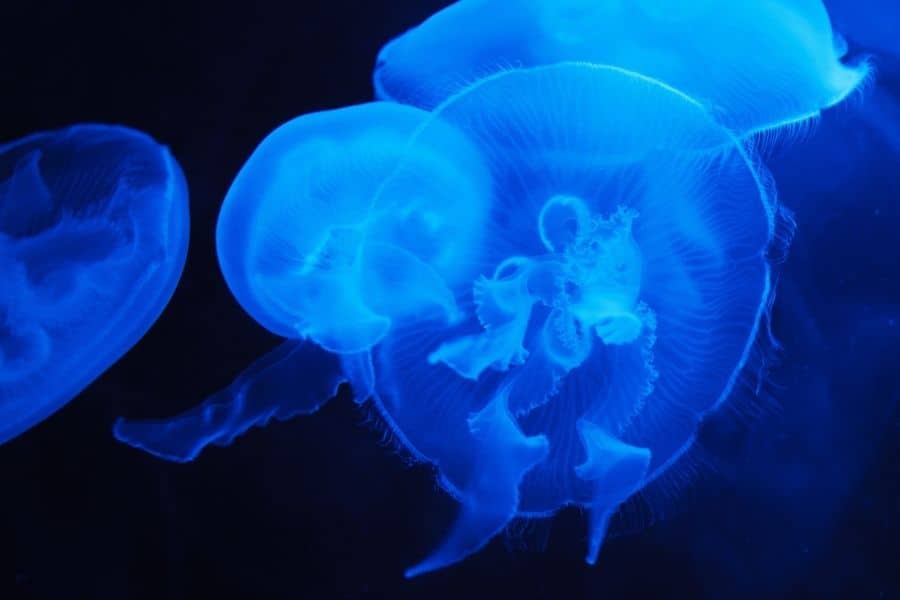
Read Next: Pregnant Neon Tetra | 21 Important Things You Need To Know |
